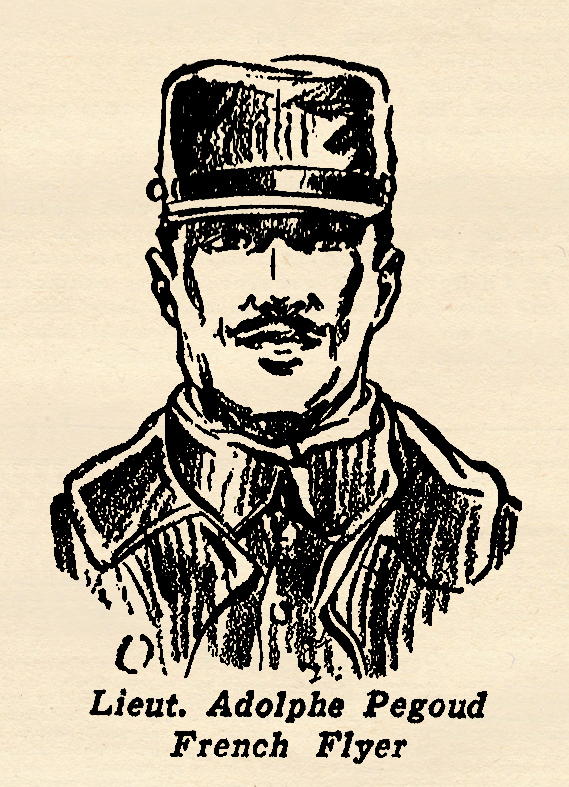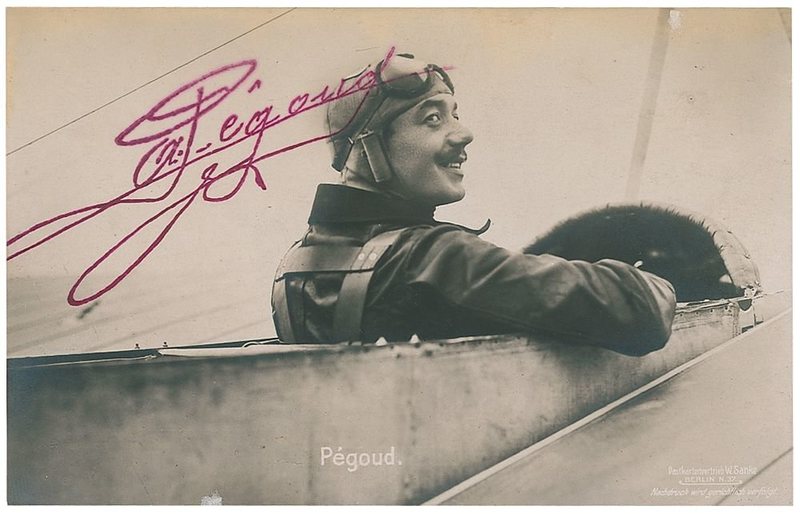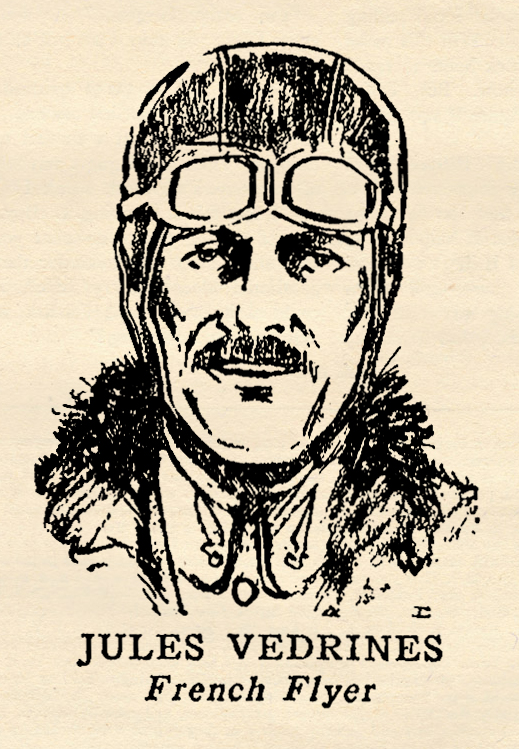Amidst all the great pulp thrills and features in Sky Fighters, they ran a true story feature collected by Ace Williams wherein famous War Aces would tell actual true accounts of thrilling moments in their fighting lives! This time we have Lt. Adolphe Pegoud of the French Flying Corp’s most thrilling sky fight!
Adolphe Pegoud was a  famous flyer before the war began. In 1913, flying a tiny Bleriot monoplane, he astonished the world by doing a series of intricate air maneuvers. Later, he made an upside down landing, the first and to this day the only aviator deliberately to perform such a stunt.
famous flyer before the war began. In 1913, flying a tiny Bleriot monoplane, he astonished the world by doing a series of intricate air maneuvers. Later, he made an upside down landing, the first and to this day the only aviator deliberately to perform such a stunt.
With Pourpe, Garros, Vedrines, and several others, he made up the first French air squadron to see action in the World War. In those days planes, frail contraptions of wood, linen and wires, were not armed. The pilots usually carried a rifle or shotgun when going aloft, and sometimes darts and hand grenades. Plane to plane fighting was unknown. The crafts were used for scouting. Pegoud changed all this when ho initiated the first air battle. He tells about it in the account below.
THE FIRST AIR BATTLE
by Lieutenant Adolphe Pegoud • Sky Fighters, October 1934
WHILE I had always carried arms while on my trips over the Boche lines and many times had passed within fifty or a hundred meters of Taube pilots, I had never thought to try out my marksmanship on the flying targets. But on this day when I was ordered aloft, I decided that I would allow no more Taube pilots to pass me by so nonchalantly. At least, I was going to let them know that there was a war taking place.
And lucky for me, I encountered my first Taube the same day I was filled with that resolve. I met him just beyond the Fortress of Verdun. He was just a speck when I first glimpsed him off to my right, but I ruddered toward him, flying as fast as my machine would carry me. At one hundred meters distance, the Taube pilot stood up in his seat and waved at me. That fact made me mad. Here I had come to kill him (if possible) and he greeted me with that friendly gesture. I waved my Lebel in the air over my head and shouted at him in French to beware. Of course, he could not hear because of the noise of the engines.
He continued on past me and I swung around and followed him. This maneuver seemed to surprise him. I continued on, coaxing my machine to its greatest speed. Finally I was not more than ten meters to the rear of his. I shouted again, made faces, then put the rifle to my shoulder and fired a bullet over his head to let him know my intentions. Though I had firmly resolved to shoot at the pilot, I realized now that I could not, for he wan apparently unarmed and had been so friendly.
When I fired at him, he must have seen the smoke from my Lebel or saw it flash. He knew then that I was not fooling and tried to escape from my plane by streaking down toward the earth. But I followed intently, my mind occupied now, not on shooting the pilot, but damaging his machine so it would have to land, thus ha would be unable to accomplish his mission.
I stood up in the pit and fired two shots at his gas tank, but nothing happened. Then I had to sit down and maneuver my plane again. The Taube pilot was zigzagging. I got closer and stood up again. This time, he too, stood up, and hurled a hand grenade back at me. But his aim was wild. It hit on the ground far below and exploded there sending up a puff of blue smoke. I aimed my rifle and rapidly fired all my remaining shells at the gas tank again.
Now I saw that something had happened. The Taube began to wobble crazily. The Boche pilot seemed frantic. Finally the motor stopped turning. Then I saw what had happened. One of my bullets had cracked the propeller, and it had shattered, throwing the Taube into terrific vibration and forcing the pilot to cut his engine.
He had to go down. I wished then that I had not been so hasty, for as it was he landed inside his own lines. If I had waited, I could have captured him by forcing his landing on our side. A fresh Taube and its Boche pilot would have been a great trophy to take home and show my mates.









 great war broke out Jules Vcdrines was the most famous flyer of France. He had twice won the Gordon Bennett speed trophy, and held both distance and altitude records. It was through his efforts that France wrested supremacy of the air from the United States and Great Britain. Along with Garros, Pegoud, Marechal, Le Blanc, Audemars, and other famous French flyers of his day, he enlisted in the French Flying Corps the day after war was declared.
great war broke out Jules Vcdrines was the most famous flyer of France. He had twice won the Gordon Bennett speed trophy, and held both distance and altitude records. It was through his efforts that France wrested supremacy of the air from the United States and Great Britain. Along with Garros, Pegoud, Marechal, Le Blanc, Audemars, and other famous French flyers of his day, he enlisted in the French Flying Corps the day after war was declared. famous flyer before the war began. In 1913, flying a tiny Bleriot monoplane, he astonished the world by doing a series of intricate air maneuvers. Later, he made an upside down landing, the first and to this day the only aviator deliberately to perform such a stunt.
famous flyer before the war began. In 1913, flying a tiny Bleriot monoplane, he astonished the world by doing a series of intricate air maneuvers. Later, he made an upside down landing, the first and to this day the only aviator deliberately to perform such a stunt.